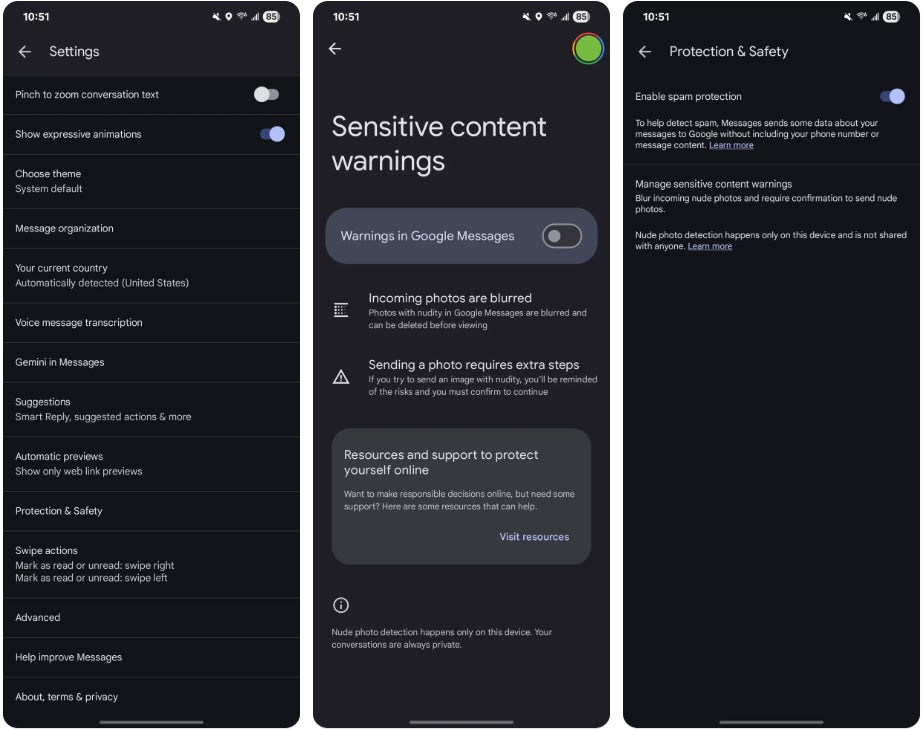Google has just officially rolled out a new safety feature on the Google Messages app for Android, allowing it to detect and blur sensitive images such as nude photos before users view or send them. This is considered an important step in protecting users, especially teenagers, from the risk of exposure to inappropriate content.

Detect and process directly on the device
The highlight of this feature is that the entire image processing and classification process takes place directly on the device, through the Android System SafetyCore system. This means that no identifying data or content is sent to Google servers, ensuring maximum privacy.
To use it, users need to sign in to their Google Account in the Messages app. When the system detects an image that is considered sensitive, the photo will be automatically blurred with options such as:
See information about why images can be harmful.
Block the sender's phone number.
View photo after confirmation.
Skip and return to the conversation without opening the photo.
The feature not only applies to receiving photos, but also displays a prompt when a user attempts to send or forward a nude photo. The sender will be asked to confirm and receive a risk warning before the message is sent.
Flexible settings according to age
Google designs different mechanisms for different age groups:
Adult users (18+): Feature is off by default, can be manually enabled in Google Messages Settings > Protection & Safety > Manage sensitive content warnings.
Supervised child accounts: Cannot be turned off without parental consent through Family Link.
Unsupervised teens 13–17: Can be turned off in Google Account Settings.
This tiering approach increases protection for vulnerable groups while still allowing adults to decide for themselves the level of protection appropriate to their individual needs.

Comparison with Apple and security implications
Apple has previously rolled out a similar feature called Communication Safety in iMessage, which blurs out pornographic images for child accounts and provides safety guides. Like Google, Apple’s entire identification process also takes place on the device to avoid data leaks.
The difference is that Apple's solution is focused primarily on teens, while Google's applies to both adults and teens, with different default settings based on age. This shows that Google is aiming to balance safety with adult user choice.
Benefits and Controversies
The Sensitive Content Warning feature offers several benefits:
Reduces the risk of exposure to harmful images, especially for young users.
Protect privacy by processing data on the device.
Provides an extra layer of security without the need for third-party apps.
There are mixed opinions, however. Some argue that the prompts can be intrusive in private conversations where consent has already been established. Having adults manually enable the feature could also lead to lower adoption rates than if it were enabled by default.
Still, with the growing prevalence of unwanted sharing of intimate images, adding a tool to help users proactively prevent them is a necessary step. The only question left is how much interference individuals are willing to accept in exchange for safety.
A Step Forward for a Safer Messaging Environment
From a technology perspective, Google’s integration of a sensitive content detection system directly into Google Messages shows a trend toward increased security and privacy in messaging platforms. It is also a positive sign that major technology companies are beginning to prioritize user protection from the design stage, instead of relying entirely on personal awareness.
As more and more people use messaging apps to share personal photos, videos , and documents, features like these are key to maintaining a safe, civil, and privacy-respecting environment. Despite some limitations, Google’s move is expected to encourage other platforms to adopt similar measures, contributing to a healthier online experience for everyone.
Source: https://baovanhoa.vn/nhip-song-so/google-messages-ra-mat-tinh-nang-lam-mo-anh-nhay-cam-161154.html




![[Photo] Firmly marching under the military flag: Ready for the big festival](https://vphoto.vietnam.vn/thumb/1200x675/vietnam/resource/IMAGE/2025/8/15/86df2fb3199343e0b16b178d53f841ec)



















![[Photo] General Secretary To Lam attends the inauguration ceremony of the "Uncle Ho in Tan Trao" Monument](https://vphoto.vietnam.vn/thumb/1200x675/vietnam/resource/IMAGE/2025/8/14/679bb11e3ce14b2aabc31a9c8676d269)

![[Photo] The special solidarity relationship between Vietnam and Cuba](https://vphoto.vietnam.vn/thumb/1200x675/vietnam/resource/IMAGE/2025/8/15/5f06c789ab1647c384ccb78b222ad18e)



![[Photo] Binh Khanh Bridge Ho Chi Minh City is ready to reach the finish line](https://vphoto.vietnam.vn/thumb/1200x675/vietnam/resource/IMAGE/2025/8/14/b0dcfb8ba9374bd9bc29f26e6814cee2)

































































Comment (0)